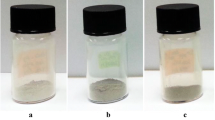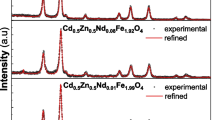Abstract
In this work we present the study of the structural, magnetic, and hyperfine properties of Gd-doped SnO2 nanoparticles synthesized by a polymer precursor method. The X-ray diffraction data analysis shows the formation of the rutile-type structure in all samples with Gd content from 1.0 to 10.0 mol%. The mean crystallite size is ~11 nm for the 1.0 mol% Gd-doped samples and it shows a decreasing tendency as the Gd content is increased. The analysis of magnetic measurements indicates the coexistence of ferromagnetic and paramagnetic phases for the 1.0 mol% Gd-doped sample; however, above that content, only a paramagnetic phase is observed. The ferromagnetic phase observed in the 1.0 mol% Gd-doped sample has been assigned to the presence of bound magnetic polarons which overlap to create a spin-split impurity band. Room-temperature 119Sn Mössbauer measurements reveal the occurrence of strong electric quadrupole interactions. It has been determined that the absence of magnetic interactions even for 1.0 mol% Gd-doped sample has been related to the weak magnetic field associated to the exchange interaction between magnetic ions and the donor impurity band. The broad distribution of electric quadrupole interactions are attributed to the several non-equivalent surroundings of Sn4+ ions provoked by the entrance of Gd3+ ions and to the likely presence of Sn2+ ions. The isomer shift seems to be nearly independent of the Gd content for samples with Gd content below 7.5 mol%.







Similar content being viewed by others
References
Adhikari R, Das AK, Karmakar D, Ghatak J (2010) Gd-doped SnO2 nanoparticles: structure and magnetism. J Magn Magn Mater 322:3631–3637
Aragón FH (2013) Study of the origin of non-conventional magnetism in metal-doped SnO2 nanoparticles. PhD. thesis, University of Brasilia, Brasília
Aragón FH, Coaquira JAH, Candela DS, Baggio Saitovitch E, Hidalgo P, Gouvêa D, Morais PC (2010a) Structural and hyperfine properties of Cr-doped SnO2 nanoparticles. J Phys 217(012079):1–4
Aragón FH, Coaquira JAH, Hidalgo P, Brito SLM, Gouvêa D, Castro RHR (2010b) Structural and magnetic properties of pure and nickel doped SnO2 nanoparticles. J Phys 22(496003):1–9
Aragón FH, Chitta VA, Coaquira JAH, Hidalgo P, Brito HF (2013a) Long-range ferromagnetic order induced by a donor impurity band exchange in SnO2:Er3+ nanoparticles. J Appl Phys 114(203902):1–7
Aragón FH, Coaquira JAH, Hidalgo P, Cohen R, Nagamine LCCM, da Silva SW, Morais PC, Brito HF (2013b) Experimental evidences of substitutional solution of Er dopant in Er-doped SnO2 nanoparticles. J Nanopart Res 15(1343):1–10
Castro RHR, Hidalgo P, Coaquira JAH, Bettini J, Zanchet D, Gouvêa D (2005) Surface segregation in SnO2–Fe2O3 nanopowders and effects in Mössbauer spectroscopy. Eur J Inorg Chem 11:2134–2138
Coey JMD, Douvalis AP, Fitzgerald CB, Venkatesan M (2004) Ferromagnetism in Fe-doped SnO2 thin films. Appl Phys Lett 84:1332–1334
Coey JMD, Venkatesan M, Fitzgerald CB (2005) Donor impurity band exchange in diluted ferromagnetic oxides. Nat Mater 4:173–179
Coey JMD, Wongsaprom K, Alaria J, Venkatesan M (2008) Charge-transfer ferromagnetism in oxide nanoparticles. J Phys D 41:134012
Dietl T, Ohno H, Matsukura F, Cibert J, Ferrand D (2000) Zener model description of ferromagnetism in zinc-blende magnetic semiconductors. Science 287:1019–1022
Dimri MC, Khanduri H, Kooskora H, Subbi J, Heinmaa I, Mere A, Krustok J, Stern R (2012) Ferromagnetism in rare earth doped cerium oxide bulk samples. Phys Status Solidi A 209:353–358
Duan LB, Chu WG, Yu J, Wang YC, Zhang LN, Liu GY, Liang JK, Rao GH (2008) Structural and magnetic properties of Zn1−x Co x O (0 < x ≤ 0.30). J Magn Magn Mater 320:1573–1581
Espinosa A, Sánchez N, Sánchez-Marcos J, Andrés A, Muñoz C (2011) Origin of the magnetism in undoped and Mn-doped SnO2 thin films: Sn versus oxygen vacancies. J Phys Chem C 115:24054–24060
Fitzgerald CB, Venkatesan M, Dorneles LS, Gunning R, Stamenov P, Coey JMD, Stampe PA, Kennedy RJ, Moreira EC, Sias US (2006) Magnetism in dilute magnetic oxide thin films based on SnO2. Phys Rev B 74(115307):1–10
Freeman and Catlow (1990) A computer modeling study of defect and dopant states in SnO2. J Solid State Chem 85:65–75
Gouvêa D, Smith A, Bonnet JP (1996) Manganese segregation on the surface of SnO2 based powders. Eur J Solid State Inorg Chem 33:1015–1023
Hays J, Punnoose A, Baldner R, Engelhard MH, Peloquin J, Reddy KM (2005) Relationship between the structural and magnetic properties of Co-doped SnO2 nanoparticles. Phys Rev B 72:075203
Heiman D, Shapira Y, Foner S, Khazai B, Kershaw R, Dwight K, Wold A (1984) Exchange energy, magnetization, and Raman scattering of (Cd, Mn)Se. Phys Rev B 29:5634–5640
Hidalgo P, Castro RHR, Coelho ACV, Gouvêa D (2005) Surface segregation and consequent SO2 sensor response in SnO2–NiO. Chem Mater 17:4149–4153
Jung MGK, Park H, Jang HM, Ryu S, Kim YM (2004) Co-metal clustering as the origin of ferromagnetism in Co-doped ZnO thin films. Appl Phys Lett 84:1338–1340
Karen P, Woodward PM (1998) Liquid-mix disorder in crystalline solids: ScMnO3. J Solid State Chem 141:78–88
Kiliç Ç, Zunger A (2002) Origins of coexistence of conductivity and transparency in SnO2. Phys Rev Lett 88(095501):1–4
Larson AC, Von Dreele RB “GSAS: General Structural Analysis System” Los Alamos National Laboratory, Los Alamos NM (1994)
Limaye MV, Singh SB, Das R, Poddar P, Kulkarni K (2011) Room temperature ferromagnetism in undoped and Fe doped nanorods: microwave-ssisted synthesis. J Solid Stat Chem 184:391–400
Ohno H (1998) Making no magnetic semiconductor ferromagnetic. Science 281:951–956
Panigrahy B, Aslam M, Misra DS, Bahadur D (2011) Structural, optical and magnetic properties of Gd-doped ZnO nanorods by novel aqueous solution method. Int J Nanosci 10:629–633
Pechini M (1967) U.S. patent 3,330,697
Punnoose A, Hays J (2005) Possible metamagnetic origin of ferromagnetism in transition-metal-doped SnO2. J Appl Phys 97: 10D321 1–3
Punnoose A, Hays J, Gopal V, Shutthanandan V (2004) Room-temperature ferromagnetism in chemically synthesized Sn1−x Co x O2 powders. Appl Phys Lett 85:1559–1561
Qi J, Gao D, Liu J, Yang W, Wang Q, Zhou J, Yang Y, Liu J (2010) Magnetic properties of Er-doped ZnO films prepared by reactive magnetron sputtering. Appl Phys A 100:79–82
Rahman G, García-Suárez VM, Hong SC (2008) Vacancy-induced magnetism in SnO2: a density functional study. Phys Rev B 78:184404 1–184404 5
Sambasivam S, Joseph D, Jeong J, Choi B, Lim K, Kim S, Song T (2011) Antiferromagnetic interactions in Er-doped SnO2 DMS nanoparticles. J Nanopart Res 13:4623–4630
Sundaresan A, Bhargavi R, Rangarajan N, Siddesh U, Rao CNR (2006) Ferromagnetism as a universal feature of nanoparticles of the otherwise nonmagnetic oxides. Phys Rev B 74(161306):1–4
Togo A, Oba F, Tanaka I, Tatsumi K (2006) First-principles calculations of native defects in tin monoxide. Phys Rev B 74(195128):1–8
Acknowledgments
This work was financially supported by the Brazilian agencies CNPq, CAPES, FAP/DF, and FAPESP (proc. 2011/50556-0) Authors want to thank Dr. E. Guimarães for her help with the XRD experiments.
Author information
Authors and Affiliations
Corresponding author
Rights and permissions
About this article
Cite this article
Coelho-Júnior, H., Aquino, J.C.R., Aragón, F.H. et al. Doping effects on the structural, magnetic, and hyperfine properties of Gd-doped SnO2 nanoparticles. J Nanopart Res 16, 2689 (2014). https://doi.org/10.1007/s11051-014-2689-3
Received:
Accepted:
Published:
DOI: https://doi.org/10.1007/s11051-014-2689-3




